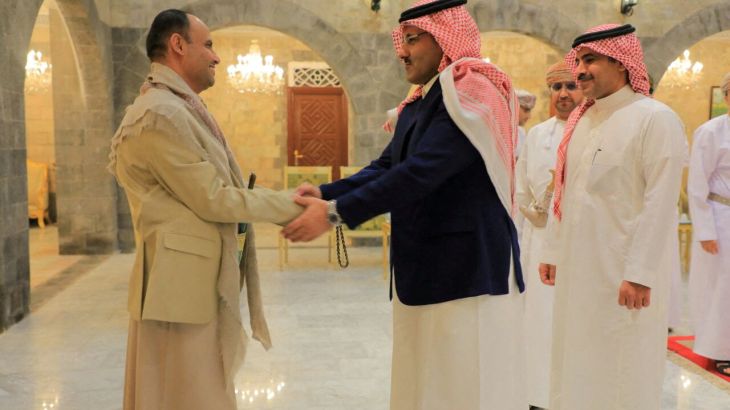A timeline of Yemen’s slide into conflict and war
A timeline of the Yemen crisis, from the 1990s to current day.

Saudi and Omani delegations have been holding talks with Houthi officials in the Yemeni capital Sanaa as Riyadh seeks to end its military involvement in the latest chapter of conflict in Yemen’s modern history.
Following is a timeline of Yemen’s slide into conflict:
Keep reading
list of 4 itemsCould talks in Yemen end years of war?
Saudi, Omani envoys hold peace talks with Houthi leaders in Yemen
Saudi-led coalition lifts import restrictions in south Yemen
1990: North and South Yemen unified to form a single state under President Ali Abdullah Saleh.
1994: In a civil war, Saleh prevents southern Yemen – angered by what it sees as its lower status – from splitting with northern Yemen.
2003-09: A Houthi group in northern Yemen protests marginalisation of the local Zaydi Shia Muslim sect, and fights six wars with Saleh’s forces and one with Saudi Arabia.
2011: Arab Spring protests undermine Saleh’s rule, leading to splits in the army and allow al-Qaeda in the Arabian Peninsula (AQAP) to seize territory in the east.
2012: Saleh steps down in a political transition plan backed by Gulf states. Abd-Rabbu Mansour Hadi becomes interim president and oversees a national dialogue to draft a more inclusive, federal constitution.
2013-14: AQAP stages attacks across Yemen. The Houthis seize the capital Sanaa in September 2014 with help from Saleh and demand a share of power.
2015: Hadi tries to announce a new federal constitution opposed by the Iran-aligned Houthis and Saleh, who arrest him. He escapes, pursued by the Houthis.
Saudi Arabia, leading a coalition, intervenes in March, driving the Houthis and Saleh loyalists from Aden in south Yemen and from Marib, northeast of Sanaa. The front lines solidify, heralding years of deadlock.
2016: AQAP establishes a mini-state around Mukalla. The UAE backs local forces in a battle that ends AQAP rule there.
Hunger grows as the coalition imposes a partial blockade on Yemen, claiming Iran is smuggling missiles to the Houthis, which Iran denies. Coalition air raids that kill civilians prompt warnings from human rights groups, but Western support for the military campaign continues.
2017: The Houthis fire a growing number of missiles deep into Saudi Arabia.
Saleh switches sides but is killed trying to escape the Houthis.
2018: Coalition-backed forces advance up the Red Sea coast against the Houthis, aiming to take the port of Hodeidah, which handles the bulk of Yemen’s commercial and aid imports. A military deadlock ensues.
Peace talks are held in Sweden, the first in two years, and the warring sides agree to a truce and a troop withdrawal from Hodeidah. Work on a prisoner swap begins.
2019: The Hodeidah truce mostly holds but the withdrawal fails to materialise. Violence continues elsewhere.
The UAE largely ends its presence, while still supporting local allies – including southern separatists who seize Aden in August.
Riyadh brokers a power-sharing deal between separatists and Hadi’s government but implementation only begins in 2020.
2020: The Saudi-led coalition announces a truce prompted by COVID-19 but no progress is made to forge a permanent ceasefire and violence continues, although the warring sides do complete a prisoner swap.
An attack on Aden airport moments after a plane lands carrying the newly formed power-sharing government kills at least 22 people. Riyadh and Hadi’s government blame the Houthis.
2021: US President Joe Biden revokes the US “terrorist” designation place on the Houthis, while also ending US support for offensive coalition operations.
The Houthis intensify an offensive to seize gas-rich Marib, the government’s last stronghold in northern Yemen.
The UN and US envoys try to engineer a permanent truce and reopening of air and sea links to Houthi areas, but the warring sides resist compromise. Saudi Arabia and Iran launch direct talks, mostly focused on Yemen.
2022: Houthis extend missile and drone attacks to the UAE after Emirati-backed local militias battle the group in energy-producing Shabwa and Marib. Coalition warplanes pummel Yemen.
The US acts to boost the military capabilities of Gulf allies amid strained relations and intensifying Houthi assaults on Saudi oil facilities.
President Hadi cedes power to a presidential council in April as Riyadh acts to strengthen the anti-Houthi alliance.
The warring parties agree a truce deal in April, which is rolled over twice and expires in October without an agreement to extend. But a tentative calm holds.
2023: In March, Saudi Arabia and Iran agree to restore relations, raising hopes that the Yemen peace process could see progress.
In April, Saudi and Omani envoys visit Sanaa aiming to negotiate a permanent ceasefire deal with the Houthis. The same month, Yemeni rebels and government forces free scores of prisoners on the last of a three-day exchange of more than 800 detainees.